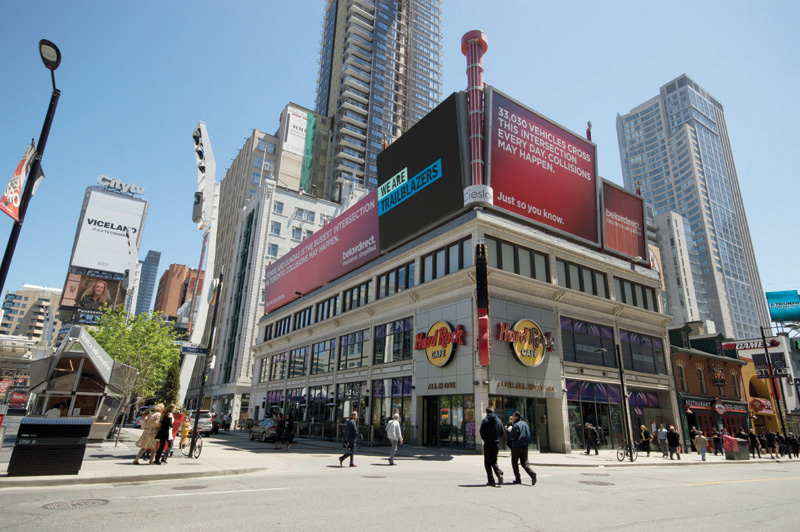A structural issue
One of the challenges of replacing Cieslok’s multiple boards with a unified digital face was addressing the increased weight load on the heritage building, which is slated to become a flagship Shoppers Drug Mart store later this year. Compared to the previous rooftop signs, which were 6.4 to 6.7 m (21 to 22 ft) in height, the screen would be not only heavier, but also taller and, thus, would need to endure a higher wind load.
Cieslok worked in advance with the municipal government and its heritage preservation department to acquire the necessary permits to alter the building.
“The process involved two years of backroom discussions before they got the go-ahead,” says Edwards. “Once they had developed early drawings of the sign, an architect developed a plan to put in a more pragmatic sign structure and an outside engineering firm determined what specifically needed to be done.”
Cieslok hired Enseicom, a sign, billboard and street furniture manufacturer based in Lachine, Que., to fabricate a steel structure for the purpose.
“Then we put the new steel structure atop the building to support the screen,” says Rushton. “The building’s existing substructure was also enhanced so it could support an additional 35,380 kg (78,000 lb). We built the sign around that base structure.”
The older signs were removed from the roof in March and the new steel structure was installed in April.
Pixel by pixel
As for the LEDs, MRI sourced surface mount diode (SMD) products with a 10-mm (0.39-in.) pixel pitch from a manufacturing operation in which it is a joint venture partner.
“We had someone overseeing every single LED,” says Rushton. “You need integrated binning of LEDs to achieve uniformity of colours. And for that, you have to ensure control of the whole supply chain. This is especially important with a tight timeline. Once we got our own go-ahead earlier, we had to build everything as quickly as possible.”
The scale of the fabrication process was massive. The screen comprises an array of nearly 4.7 million pixels, each of which combines a trio of red, green and blue (RGB) LEDs with a white lens for optimal light diffusion.
“The very tight pixel pitch represented the further evolution of what we had done in the past,” says Rushton. “We had to put the modules together one-by-one to make sure they fit perfectly. We couldn’t be ‘off’ in any direction by even 1 mm (0.04 in.). Fortunately, the fabrication process went well, because we had already done a lot of planning.”
The pixels were assembled into tiles, each measuring a little over 0.09 m2 (1 sf), with 1,024 pixels per tile. Then those tiles were further collected into subsections of cabinets.
“The screen is so big,” says Edwards, “even with its rounded corner, it took up most of our floor.”
The system for controlling the LEDs, also proprietary to MRI, is almost fully redundant.
“I come from a software background and we applied networking principles to this board to optimize uptime,” says Rushton. “We have set up a pretty sophisticated control room with high-end computing equipment to ensure it always continues to run. If anything goes wrong in terms of fan speed, the temperature of each module, etc., we get an alert on our smartphones, so we know right away. And we have mobile technicians who can fix it in an hour or two.”






